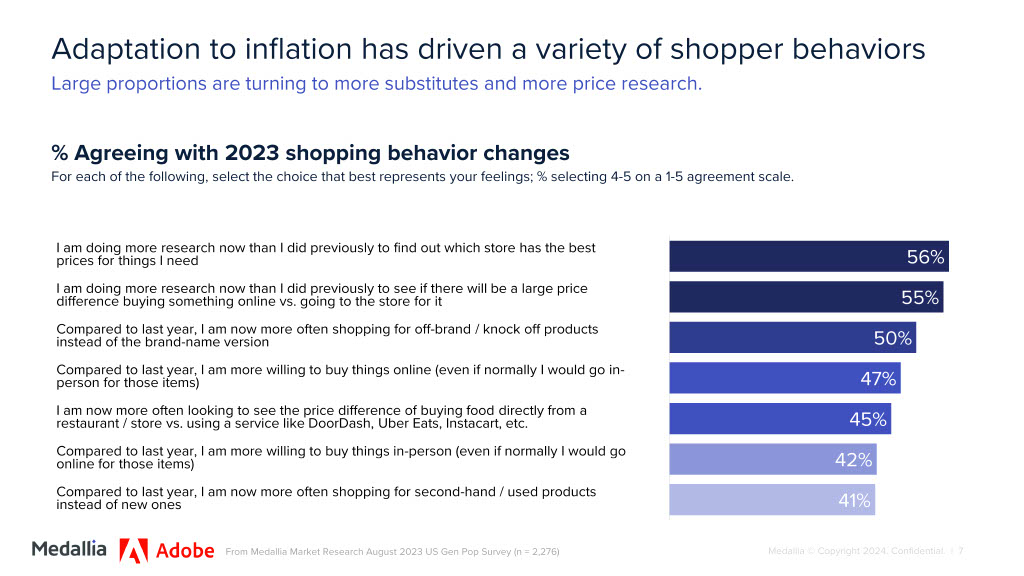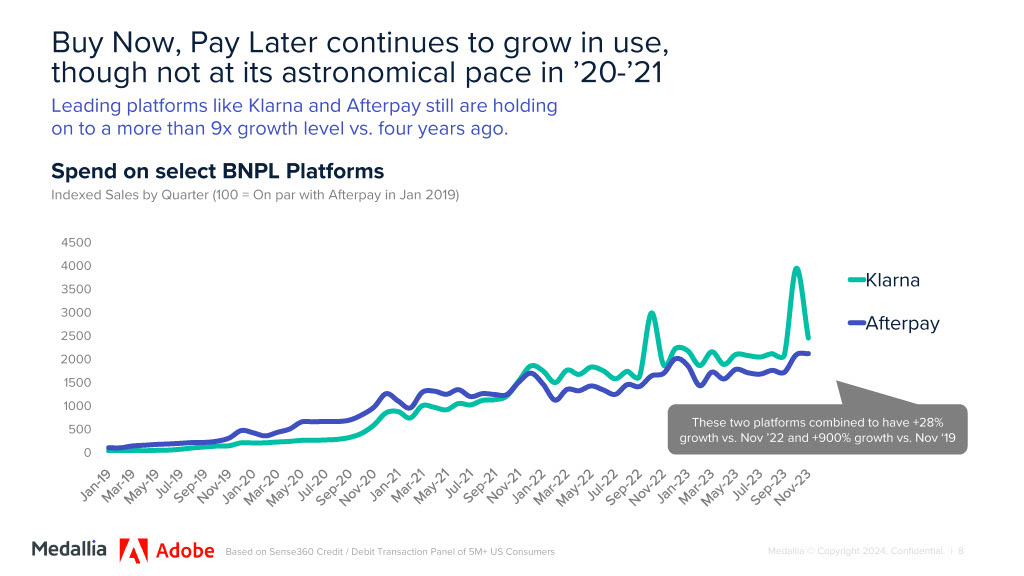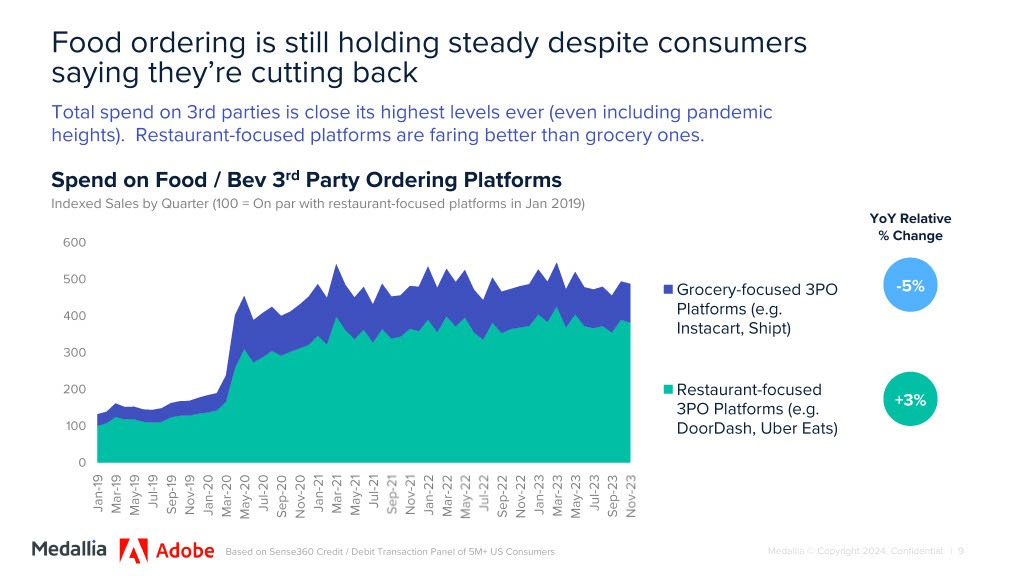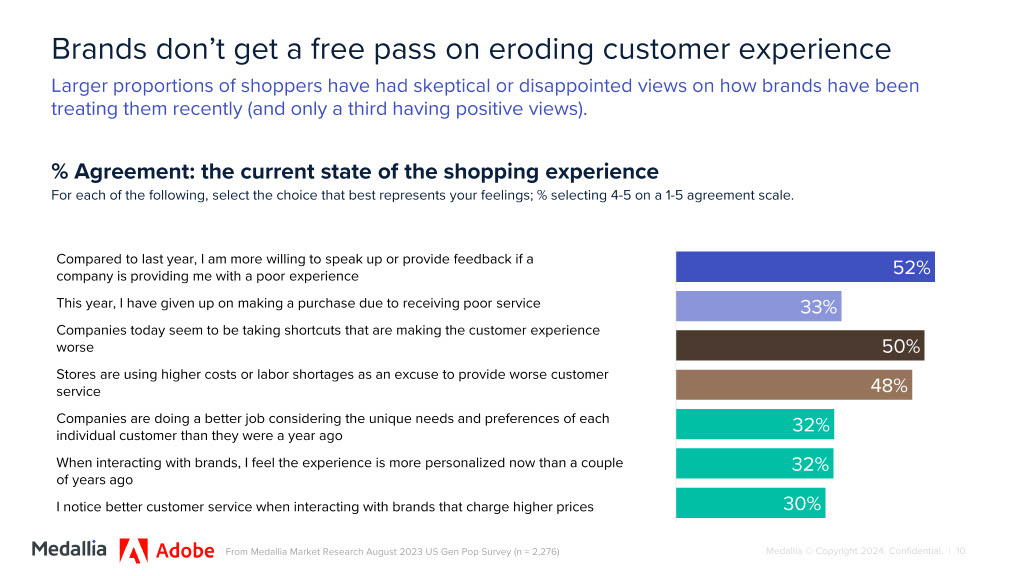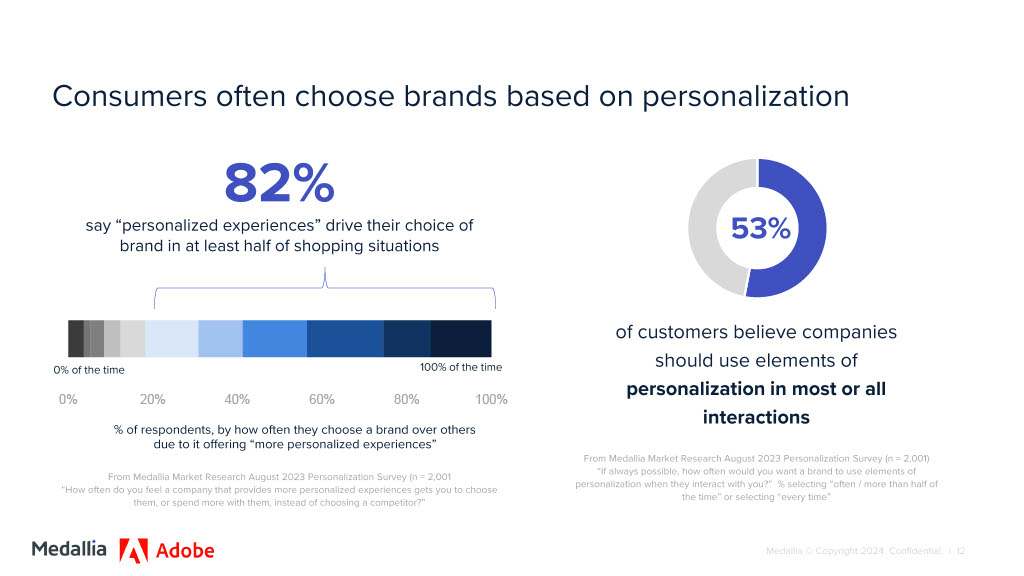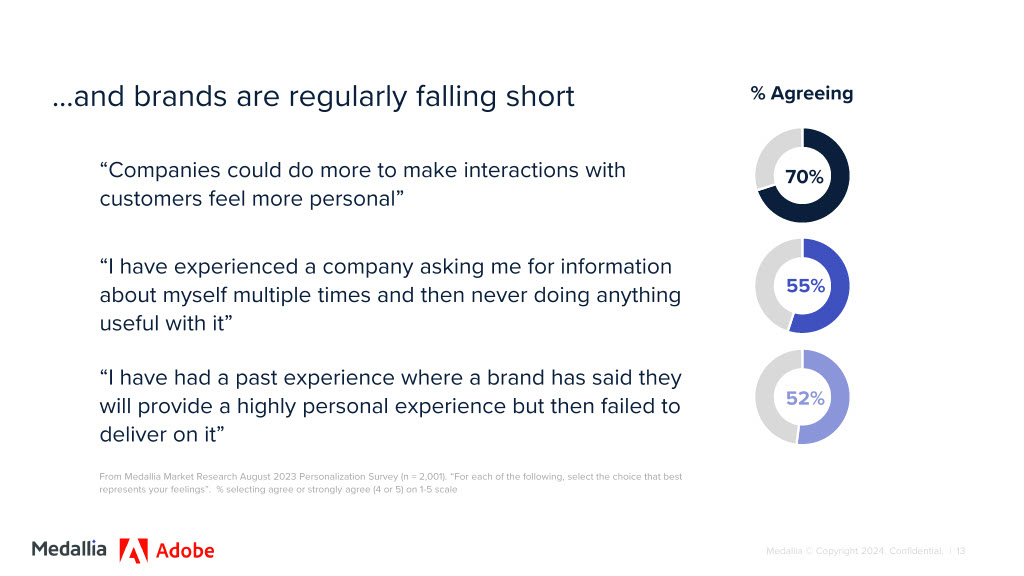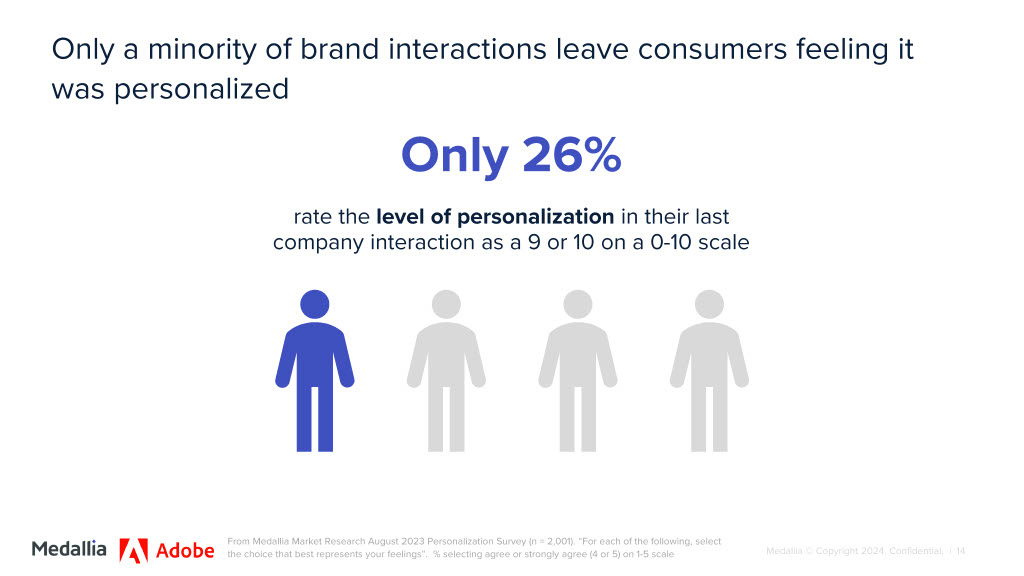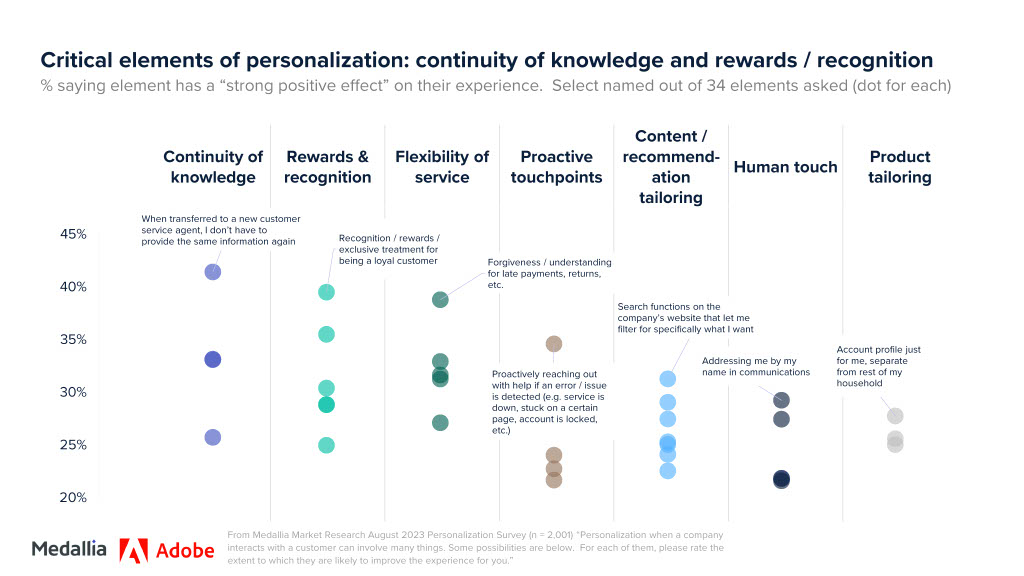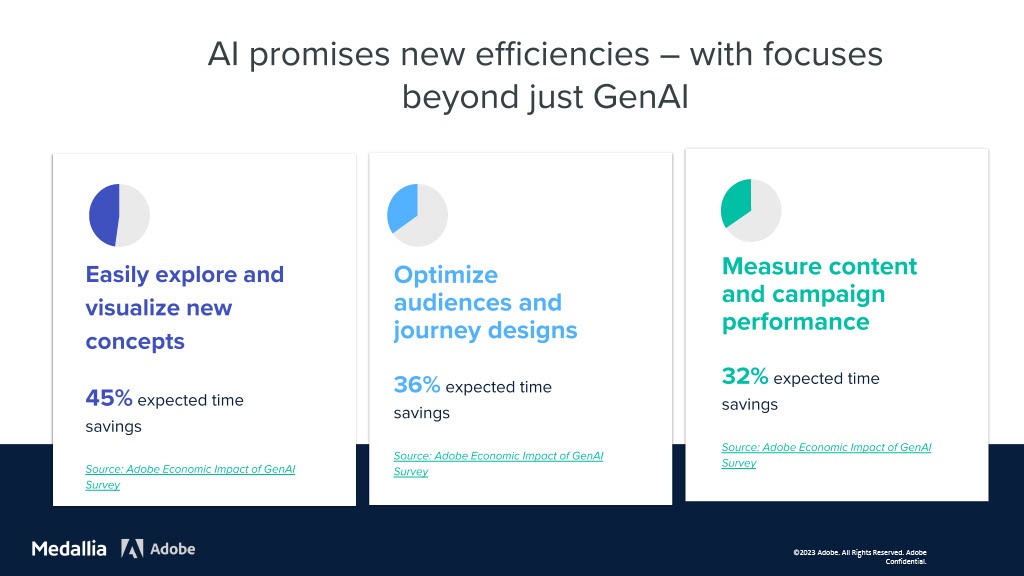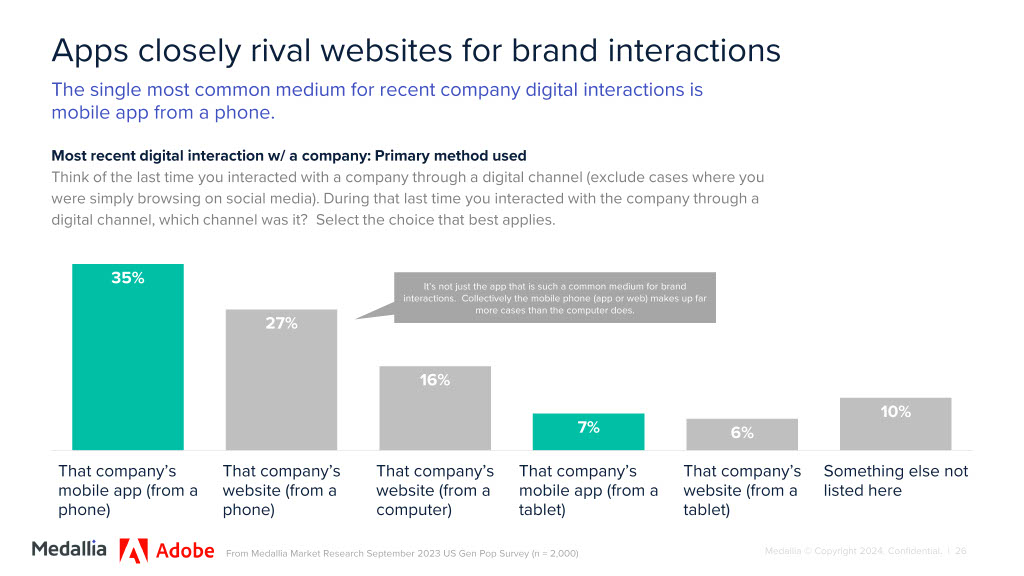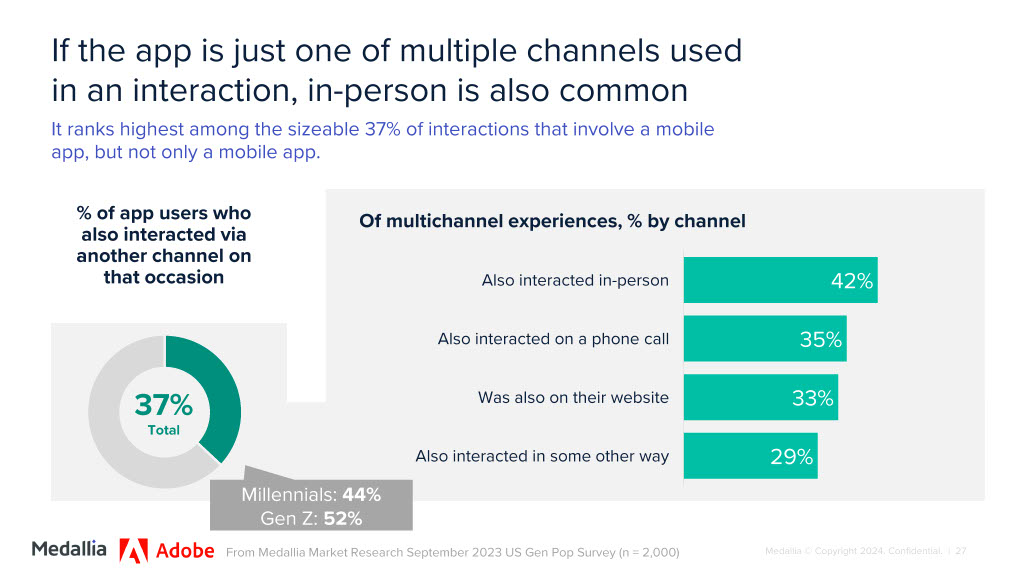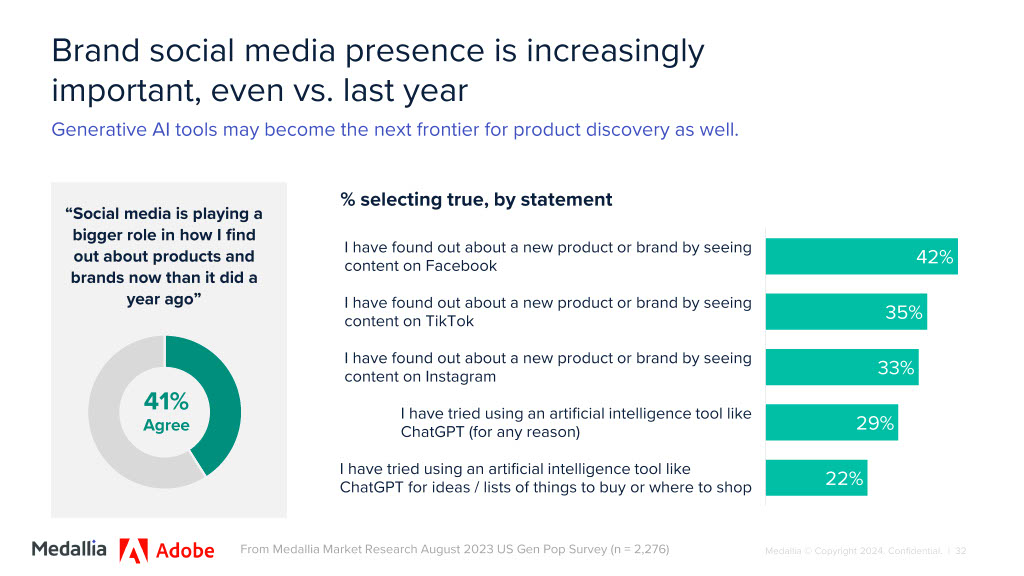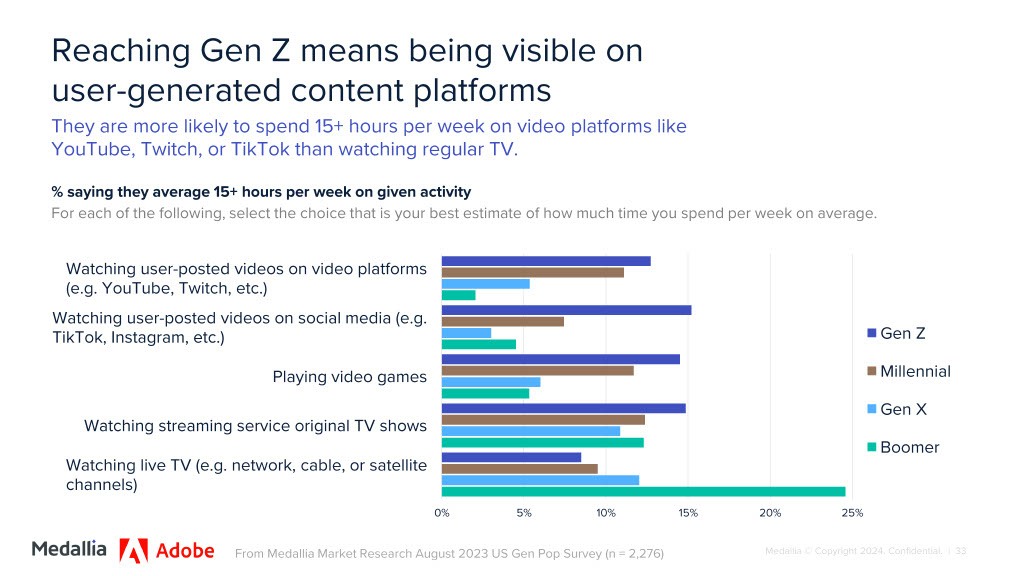Digital Customer Experience Trends to Watch in 2024
March 20, 2024
Customer Experience
What consumers think, how they behave online, and how they make shopping decisions are constantly evolving. That’s especially true in the digital customer experience landscape, as new preferences, channels, and ways for customers and brands to interact emerge.
To bring us up to speed on what’s unfolding right now and offer predictions for what’s to come throughout the year ahead, Medallia’s Andrew Custage, the Head of Market Research Insights and Adobe’s Bruce Richards, Industry Strategy and Marketing Lead, Retail & Consumer Goods, teamed up to present their findings on this topic in a joint webinar: Digital Customer Experience Trends to Watch in 2024.
A recording of this engaging conversation is now available to watch on demand, and ahead we’ll share the top takeaways and latest research from their presentation, including the role of artificial intelligence (AI) and predictive analytics in shaping digital customer experiences, how consumers navigate digital channels and physical experiences across their journeys, key differences across age groups, and how the economy is impacting the overall customer experience (CX).
The Top 15 Digital Customer Experience Trends & Insights in 2024
1. The current macroeconomic environment is shaping the omnichannel customer journey and purchase decision-making
Custage explains that consumers are doing more research now to make “the best decision of what to buy and where to buy it.” More than half (55-56%) say they’re spending more time looking up things than they previously did, such as where they can get the best deal for buying a product they want and how much the price difference is between what’s available online versus in person. Similarly, about 50% say they’re willing to trade down to cheaper products, 41% say they’re shopping for second-hand or used items, and 45% are price comparing before ordering, seeing the difference between what restaurants and stores and third-party services like DoorDash and Uber Eats charge.
2. In the face of economic challenges, CX matters more than ever
“Brands can’t always control what consumers are going to do,” says Richards. Whether customers opt to search for better prices remains beyond the control of the businesses. What they can influence is the experiences they offer that can “hopefully override that price sensitivity over time,” he adds.
Providing the best possible experience is important because experience is another factor that shapes the purchasing decision. In fact, as many as 73% of consumers say they factor customer experience into their purchasing decisions.
Adobe has a saying: Consumers don’t buy products, they buy great experiences. “So we’d like to think that after all of this price volatility dies down, the winners in this space are going to be the ones who focused on delivering great customer experiences,” says Richards.
Brands won’t be able to guarantee that every price sensitive consumer will stick around, he adds, but the majority will because of the value of premium experiences.
3. Digital purchasing platforms are becoming an important part of the digital customer journey
Medallia Market Research has seen a huge uptick in the use of digital purchasing buy-now, pay-later platforms like Klarna and Afterpay.
“We’ve seen even year over year, they’ve continued to grow, building on what’s been ninefold or even more growth over the past four years,” says Custage.
4. Retailers need to ensure buy-now, pay-later payment options are seamlessly integrated into their digital customer experience
According to Adobe reporting, buy-now, pay-later options accounted for $16.6 billion in sales throughout the 2023 holiday shopping period and $75 billion across total spending in 2023.
“That’s a 14% growth year over year…and it’s becoming a very big part of a lot of consumers’ behavior…especially in the context of price sensitivity,” says Richards. “It’s a way for them to have immediate gratification, get what they want, but maybe spread those payments a little bit more over time.”
With affordability on the line, retailers need to make sure buy-now, pay-later features are seamlessly integrated into their checkout experience — they shouldn’t feel like a separate, standalone offering that takes customers out of the overall experience, he adds.
5. The rise in popularity of buy-now, pay-later options also offer new opportunities for personalization and engagement
These platforms offer a wealth of customer signals that can shed light on consumer behavior and preferences. Retailers that pull this customer data in as part of their broader customer profiles can gain a better understanding of how individuals are interacting with their brand.
These insights can allow companies to “curate experiences for consumers based on their spending habits,” says Richards.
Not only that, these platforms become vehicles for interacting with customers and can be leveraged as a communications channel for delivering personalized messaging, as well as a product discovery engine through which consumers can learn about new items and offers.
6. The new digital customer experience is inclusive of customers’ experiences using third-party platforms
For food and grocery brands, consumer spending on third-party ordering platforms remains here to stay.
“There is this permanent, sizable percentage of business that is going to happen outside of a brand’s four walls, and they don’t always have full control over that experience,” explains Custage.
In this context, it’s more important than ever for retailers to work closely with these ordering platform partners to make sure that they’re meeting customer expectations and enhancing customer satisfaction. It’s up to leaders to “hold them accountable down the value chain” for consistent experiences across the board, regardless of whether customers are interacting directly with a company or via a third party, adds Richards.
7. Consumers feel like their experiences are getting worse — and the average customer is likely to churn after less than three bad experiences
According to a recent Medallia Market Research study, half of consumers say companies are taking shortcuts that are having a negative impact on the customer experience. Meanwhile Adobe research indicates that now consumers are walking away from brands after an average of just 2.4 bad experiences. Not only that, it takes about 6.5 good experiences to get customers to become loyal again after churning.
“It’s much easier to keep them and do what you need to do to keep them from an experiential perspective than it is to get them back after they walk away,” explains Richards.
8. Personalization is a powerful driver of brand choice
For most consumers, personalized experiences influence brand choice when shopping, at least half of the time, and more than half say companies should use personalization in most of or all of their interactions.
Yet at the same time, businesses aren’t doing enough to meet their personalization expectations, with only about one in four consumers rating their last brand interaction as a truly personalized experience.
9. Some of the most important elements of personalization include knowing who consumers are across touchpoints, and rewarding and recognizing loyal customers
Although personalization can mean a variety of different things, depending on who you ask, Medallia Market Research has found that brands get personalized experiences right when they:
- Ensure continuity of knowledge: They have the ability to keep track of consumers across interactions, without requiring them to re-identify themselves, their needs, and their history when they move from one channel to the next.
- Offer rewards and recognition and flexibility of service (forgiveness for late payments, returns, etc.) in line with customer expectations.
- Proactively reach out to customers when errors or issues are detected.
10. Leading brands are investing in unified data and predictive analytics capabilities, tailored content, and journey orchestration solutions to deliver personalization at scale
Businesses need to have a 360-degree customer view, use AI-powered predictive analytics to “present the right visual and verbal messages” to each customer, and orchestrate real-time, behavior-triggered omnichannel customer journeys across physical and digital touchpoints that offer the next-best experience for customers.
“There’s a big difference between what we’ll call ‘personalization’ and ‘personalization at scale,’” says Richards. “The word ‘scale’ is critical here because there are a lot of brands out there that are very confident in their ability to personalize, but they’re only doing it maybe in one channel…but if you’re only doing it in one channel, you’re leaving a lot on the table. Because as we’ve talked about, the reality is consumers are engaging with you in many different ways. So if you’re not figuring out how to talk to every customer on every channel in real time, which is the ‘at scale’ piece, you’re missing a huge opportunity to personalize their entire experience.”
11. Advanced organizations are establishing personalization centers of excellence (COE) and adopting agile marketing squads to accelerate personalized experiences
Companies at the head of the personalization maturity curve are creating COEs with a dedicated team that includes a mix of business and IT professionals with C-level sponsorship that are responsible for defining the organization’s personalization strategy and business use cases, redesigning business processes to support personalization, and driving implementation across the entire company.
Not only are they leveraging COEs, the most effective brands are also building out agile marketing pods that are focused on specific generational audience cohorts or a specific stage within the customer lifecycle. Their goal is to determine new tactics and ideas to address personalization for these specific segments, specifically in a test-and-learn environment.
“Each pod lives within this bigger group of a functional community where they all interact with one another, and they share best practices and figure out what’s working and what’s not working,” explains Richards.
12. Companies are using AI to save time creating new concepts, optimize audience and journey insights, and measure campaign performance
Companies are using AI for personalization in a variety of ways, and three of the biggest time-saving use cases Adobe researchers have identified include developing new concepts, optimizing audiences, and measuring performance.
13. The new customer journey is neither entirely digital or entirely physical
When asked to describe their shopper journey for events like Black Friday or Cyber Monday, what stands out is that “many, many consumers — very large proportions in some cases — don’t follow a path that is entirely digital or entirely physical,” says Custage.
“We see a more omnichannel or mixed approach of browsing and research activities occurring in one channel, purchasing occurring in another, and then receipt of the product delivery, pickup, whatever it might be, back in a first channel, or a completely separate one from the first two,” he adds.
As a result, brands need to adapt to managing experiences across channels, not in silos.
Otherwise, they risk losing customers. In fact, Adobe researchers have found that one of the top three reasons that consumers churn from a brand is because of a lack of a seamless physical and digital experience.
14. Mobile phones are the key connector between physical and digital experiences
Mobile apps are quickly becoming one of the primary ways — if not the primary way — consumers interact with brands digitally, says Custage.
However, 37% of consumers say their most recent app interaction involved connecting with the brand via an additional channel as well, such as in person, over the phone, or on the company’s website.
That’s why brands are leaning into investing in their app functionality and enhancing the in-store mode features of their apps, adds Custage.
Companies can improve the in-store app mode experience in a variety of ways. Consumers want more real-time accurate information, fewer glitches, faster loading times, more in-store promotions, and better privacy and security features within the app, according to Medallia Market Research insights.
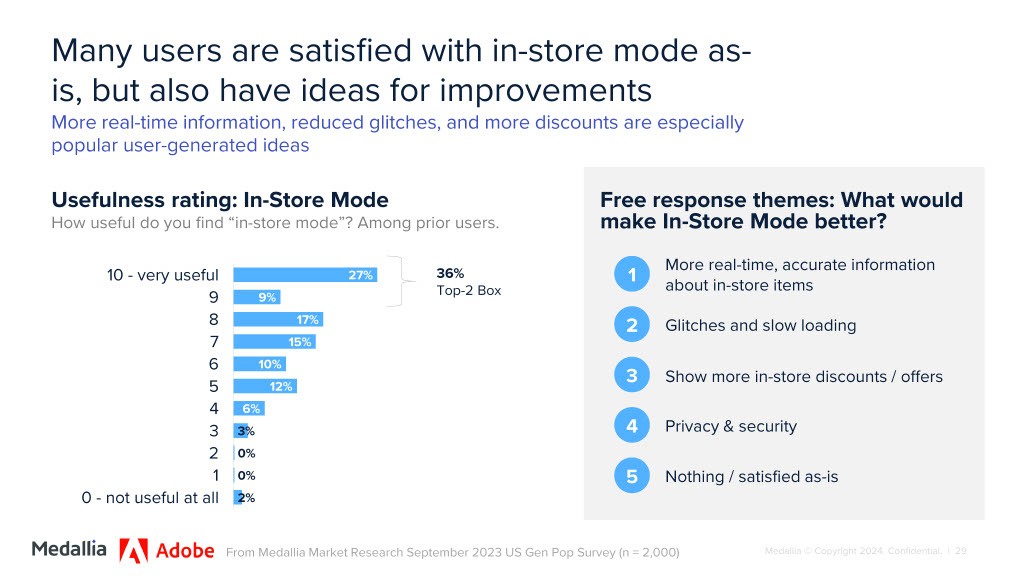
15. Social is a critical driver of product discovery
Four in 10 consumers say they’re more likely to find out about products and brands from social media now compared to a year ago, and 35% say they’ve learned about new items on TikTok and 42% say they’ve done so via Facebook.
If brands want to become more effective at reaching consumers where they’re engaging, it’s important to pay attention to where they’re spending time online. Younger generations are more likely to consume user-generated content, compared with traditional media for older generations.
Embrace the Future of Digital Customer Experience with Medallia and Adobe
Together, Medallia and Adobe provide brands with a cross-channel view of all of the interactions they have with their customers across digital channels and across their customer journeys to ensure that CX and digital teams are enabled to enhance the digital customer experience and increase acquisition, accelerate conversions, and drive repeat customer engagement.
Learn more about the Medallia and Adobe integration and watch the complete Digital Customer Experience Trends to Watch in 2024 recording for even more digital CX trends and insights.

